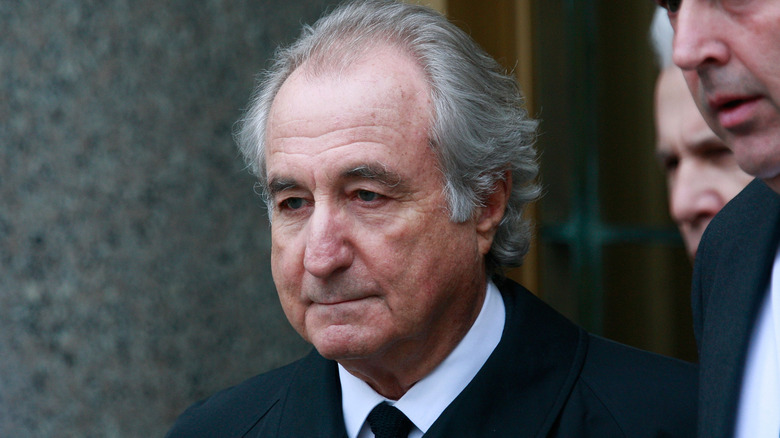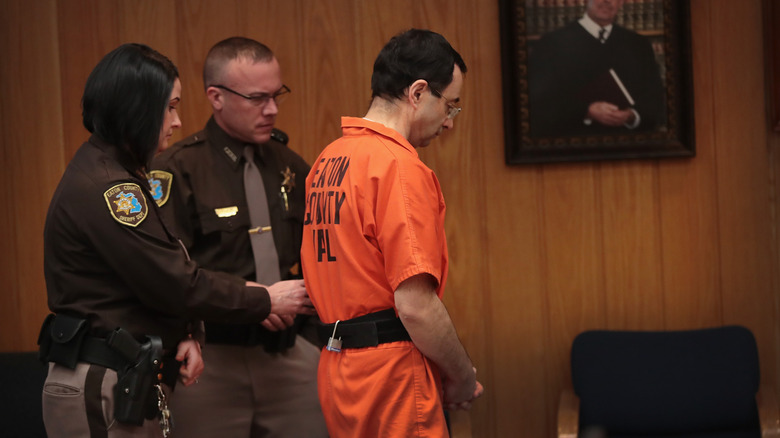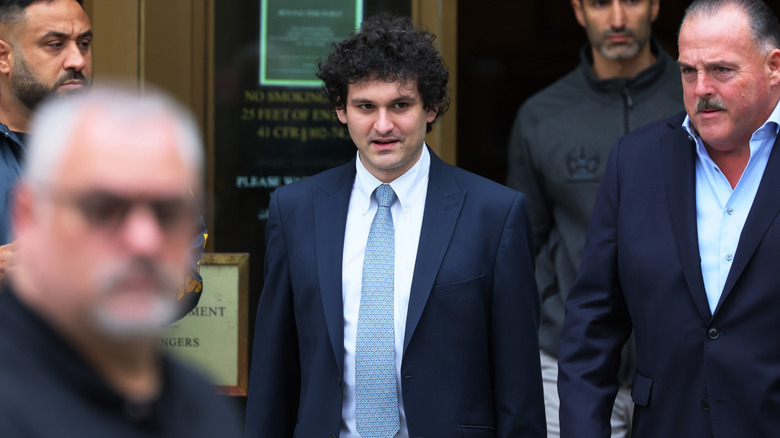The Most Scandalous Bankruptcies In Recent American History
Bankruptcy occurs when an organization can't pay its bills and needs help from the courts to resolve its financial issues. Sometimes, it's just part of doing business. A company might lose customers, fall behind on technology, or make honest mistakes. In those cases, bankruptcy provides a second chance to reorganize, fix problems, and hopefully return to profitability. This is known as Chapter 11 bankruptcy, and it doesn't always mean the end. Famous examples include General Motors, Delta Air Lines, and PG&E. All three emerged from bankruptcy and continue to operate today.
But not every bankruptcy is clean or temporary. The other type, Chapter 7, requires a company to shut down completely, sell off its assets, and close its doors for good. Some Chapter 7 cases were expected, like Circuit City, Borders, and Blockbuster, which couldn't keep up with changing markets. There was no comeback, just collapse. They were business failures, not moral ones.
Then there's the darker side of bankruptcy, the kind that makes headlines. These cases involve fraud, abuse, or shady legal maneuvers. Some companies file for Chapter 11 to escape lawsuits or shield executives. Others collapse so completely that Chapter 7 is the only option. In both cases, the damage goes far beyond financial losses. Workers lose jobs. Investors lose savings. Customers lose trust. Entire communities feel the impact. Bankruptcy in these situations isn't just about money, it's about broken trust. Here are some of the most shocking bankruptcies in recent American history.
Enron - 2001
Based in Houston, Texas, Enron started as a natural gas pipeline company but quickly grew into one of the world's most powerful energy companies. Fortune magazine dubbed Enron "America's Most Innovative Company" every year from 1996 to 2001. It claimed to be innovative and profitable, but behind the scenes, Enron was using a complex web of fake partnerships and accounting tricks to hide billions of dollars in debt. These off-the-books entities made Enron look far more profitable than it really was. Company executives and directors used this fake success to boost the stock price and cash out for $1.1 billion, according to the New York Times.
At its height, the company was ranked as America's fifth-largest, worth about $65 billion and with revenue exceeding $100 billion, those these numbers were based on fraud, according to the Levin Center. In 2001, the truth began to emerge when whistleblowers and investigations by both the SEC and the FBI confirmed Enron's massive fraud. Enron's stock, once trading at $90.75 in 2000, dropped to $0.26 in October 2001. The company filed for bankruptcy in December 2001, marking what was then the largest corporate bankruptcy in U.S. history. Twenty-five thousand employees lost their jobs and retirement savings, and, according to CNN, losses totaled $74 billion. Additionally, one of the biggest accounting firms in the world, Arthur Andersen, with 85,000 employees, also collapsed for helping Enron cover up the fraud.
In response, Congress passed the Sarbanes-Oxley Act in 2002 to tighten corporate reporting rules and hold executives more accountable. Former CEO Jeffrey Skilling, former CFO Andy Fastow, and other executives served prison time in the case. CEO Ken Lay was convicted on 10 felony counts in 2006, but he died of a heart attack before his sentencing.
WorldCom - 2002
WorldCom was once the second-largest telecommunications company in the world. It grew quickly by buying smaller companies and expanding its network across the country. At its peak, WorldCom had over 80,000 employees and was worth about $180 billion according to the New York Times. It was seen as a rising star in the tech and telecom world. However, WorldCom wasn't making enough money to keep up with its growth. Instead of telling the truth, top executives decided to "cook the books." They used fake accounting entries to make it look like the company was more profitable than it really was.
This fraud went on for years. But in 2002, an internal audit revealed the truth. The company had been falsifying its financial records and had inflated assets by more than $11 billion. The SEC fined the company $2.25 billion. WorldCom's stock crashed, and it filed for bankruptcy in July 2002 with about $105 billion in assets, the largest in U.S. history at the time. The fallout was massive, with the WorldCom scandal becoming the largest accounting scandal until Bernie Madoff's Ponzi scheme in 2008.
CEO Bernard Ebbers was found guilty of fraud and conspiracy and sentenced to 25 years in prison, per NPR. In response, lawmakers pushed for stronger rules to prevent future fraud. The Sarbanes-Oxley Act, passed in 2002, mandated that companies be more transparent and honest in their financial reporting. In 2006, Verizon purchased its remaining assets for $8.5 billion. Ebbers died in early 2020 after serving 13 years in prison.
Lehman Brothers - 2008
Lehman Brothers was one of the oldest and most respected investment banks in America. Founded in 1847, by the mid-2000s, Lehman Brothers had become the fourth-largest investment bank in the U.S. with $639 billion in assets. Unfortunately, in 2008, Lehman became the face of a global financial meltdown. The trouble began when Lehman made aggressive bets on mortgage-backed securities, many of which were high-risk or "subprime." When the housing market collapsed, those investments lost value fast. To mask its growing debt, Lehman used a controversial accounting maneuver called "Repo 105," temporarily shifting liabilities off its books to make its finances look stronger than they were.
Lehman was highly leveraged, borrowing roughly $30 for every $1 of its own capital. Hedge fund manager David Einhorn warned that the real leverage was closer to 44:1, according to a Mint report, where even a 1% drop in Lehman's assets could wipe out half the firm's equity and push its leverage toward 80:1. Lehman relied heavily on short-term borrowing to fund long-term investments. When lenders lost confidence, they stopped lending. Lehman couldn't raise cash to meet its obligations, and its liquidity dried up almost overnight. With no buyer or government bailout, the firm filed for bankruptcy on September 15, 2008, the largest corporate bankruptcy in U.S. history.
The collapse triggered a chain reaction where global stock markets plunged, banks froze lending, and millions of people lost jobs, homes, and savings. Lehman's fall was so disruptive because of how deeply it was interconnected with other banks, hedge funds, and investors worldwide. The global economy, as a result, spiraled into a deep recession. In response, the U.S. passed the Dodd-Frank Act, a sweeping reform designed to tighten oversight of financial institutions and protect consumers from future financial failures.
Bernard L. Madoff Investment Securities (BLMIS) - 2008
Bernie Madoff was once a respected figure on Wall Street. He served as chairman of NASDAQ and ran a successful investment firm called Bernard L. Madoff Investment Securities (BLMIS). But behind the scenes, he was running the largest Ponzi scheme in history. For years, Madoff promised investors steady returns of about 1% per month, regardless of the market's performance. That sounded too good to be true, and it was. Madoff wasn't investing the money. He was using new investors' funds to pay old ones, while sending out fake account statements to keep up the illusion, as the FBI documented.
Madoff's scheme collapsed in December 2008, during the height of the financial crisis. Panicked investors tried to withdraw billions, but Madoff didn't have the money. He confessed to his sons, who turned him in to the FBI. The fallout was massive, with $64.8 billion in paper wealth vanished. This was the amount investors thought they had in their accounts based on the falsified statements. The real amount of money that investors actually put into Madoff's fund over time was $19.5 billion. The scandal hit thousands of people, retirees, charities, celebrities, and schools. It also exposed major failures by regulators like the SEC, which ignored multiple whistleblower warnings for nearly a decade.
Madoff was arrested and sentenced to 150 years in prison. A court-appointed trustee spent years recovering funds, ultimately returning over $14 billion to nearly 41,000 victims across 127 countries, CNN reported. The U.S. Department of Justice also launched the Madoff Victim Fund (MVF) to compensate indirect victims, distributing over $4.3 billion. Together, it took 15 years for Madoff's victims to recover 94% of their losses. Madoff died in 2021.
Boy Scouts of America (2020)
For over 100 years, the Boy Scouts of America was one of the most trusted youth groups in the country. It taught boys how to camp, lead, and help their communities. But in 2020, the organization filed for bankruptcy, not because of money problems, but because tens of thousands of people, mostly men, came forward saying they had been abused while in the Scouts, according to the New York Times. Some of the abuse had gone on for decades. Victims stated the organization didn't do enough to protect kids or stop the abuse.
In total, more than 82,000 people filed claims, more than the number of claims against the Catholic Church. The organization faced billions of dollars in lawsuits, and to deal with the crisis, the group filed for Chapter 11 bankruptcy protection in February 2020. This allowed it to keep operating while dealing with the overwhelming number of lawsuits. The organization created a $2.4 billion fund to pay victims, one of the largest of its kind in U.S. history.
On April 19, 2023, the Boy Scouts emerged from bankruptcy and changed its name to Scouting America. The group claims to have made significant changes to ensure kids' safety, implementing new rules and providing training. Membership has dropped significantly over the years. In 1972, there were almost 5 million members. By 2021, that number had fallen to about 762,000. As of mid-2024, its enrollment was around 1 million, according to The Guardian.
Catholic Dioceses (2004–present)
Over the last 20 years, Dickinson Law at Penn State University has recorded documentation of 42 Catholic organizations in the U.S. filing for bankruptcy due to the high cost of settling sexual abuse claims. Victims accused priests and church leaders of abuse and of covering it up for decades. Instead of removing abusive priests, some dioceses simply moved them to new places, where they continued to harm more victims. Victims were often ignored or told to stay quiet. As more accusations came out, the Church faced billions of dollars in legal claims.
Additionally, in many states, new laws provided victims with the opportunity to reopen old cases that had been previously barred by statutory time limits. These "lookback windows" led to a flood of lawsuits. Chapter 11 bankruptcy has allowed many Catholic organizations and religious orders to reorganize their finances and establish settlement funds for victims. However, once a diocese or order files for bankruptcy, the process also leads to a cutoff date meaning no one can file any abuse claims that might have happened before the bankruptcy cutoff date — even if state laws change later. So far, 28 Catholic organizations have concluded the court-approved bankruptcy process.
In the U.S. alone, there have been more than 11,000 allegations of sexual abuse against Catholic clergy since 1950. In total, more than $6 billion has been paid out to settle abuse claims. The largest most recent settlement was from the Los Angeles Archdiocese at a record $880 million. The LA Archdiocese has now paid out more than $1.5 billion, according to the LA Times. The total amount nationwide is expected to rise as more victims come forward and additional lawsuits and bankruptcies are filed.
USA Gymnastics (2018)
USA Gymnastics has trained Olympic champions and inspired young athletes across the country. The organization sets the sport's rules and policies and selects the teams for the Olympics. But in December 2018, the organization filed for Chapter 11 bankruptcy due to a massive scandal involving sexual abuse. The crisis centered around Larry Nassar, once a world-renowned team doctor who abused hundreds of gymnasts, including many Olympic stars, over two decades. Investigations found that USA Gymnastics, the U.S. Olympic Committee, Michigan State University (where Nassar worked), and the FBI ignored warnings and failed to act, allowing Nassar to continue his abuse, according to NBC News.
The organization formally emerged from bankruptcy in April 2022, following a court-approved settlement plan with the survivors. In December 2021, a federal bankruptcy court approved a comprehensive settlement plan of $380 million with hundreds of abuse survivors, which USA Gymnastics outlines on its website. There were over 500 victims, with more than 300 victims of Nasser. The agreement also includes changes that give survivors a voice in how USA Gymnastics is run. These changes include giving survivors a seat on the Safe Sport Committee, the Athlete Health and Wellness Council, and even the board of directors, per PBS.
All of USA Gymnastics board members stepped down under pressure after the scandal, the New York Times reported. Nassar pleaded guilty to sexually abusing 10 minors in Michigan court in January 2018 and was sentenced to 40 to 175 years in prison. He was also sentenced to 60 years for possessing child pornography.
FTX (2022)
Founded in 2019 by Sam Bankman-Fried, FTX was a cryptocurrency exchange that became one of the world's largest digital currency exchanges. Celebrities endorsed it, and investors poured billions into the company. At its peak, FTX was worth over $32 billion. But on November 2, 2022, reports found that FTX had been misusing billions in customer funds and funneling money into risky investments and personal expenses. When customers rushed to withdraw their money and the company couldn't meet the demand, its liquidity collapsed. Bankman-Fried told investors the company needed $8 billion immediately to cover its shortfall, or it would have to file for bankruptcy, the Wall Street Journal reported.
The SEC and the Justice Department began investigating the sudden collapse of FTX, and on November 10, a Bahamian financial regulator, where the company was headquartered, froze FTX's assets. A day later, FTX filed for Chapter 11 bankruptcy, and Bankman-Fried resigned as CEO. Over one million customers potentially faced loses. Bankman-Fried was arrested a month later and extradited to the U.S. FTX's new leadership managed to recover between $14.5 billion and $16.3 billion by liquidating assets, according to the Wall Street Journal. That was more than the $11.2 billion the company owed its creditors when it collapsed.
As of October 2024, when the bankruptcy plan was approved, nearly all creditors, except the government, were set to receive 100% of their money back, plus interest. In fact, many customers were expected to receive at least 118% of the value of their accounts as of November 2022, according to the Los Angeles Times. However, many argued that it wasn't enough since Bitcoin had jumped from $16,000 to a little over $60,000 during that time. Bankman-Fried was convicted of fraud and conspiracy in November 2023 and sentenced to 25 years in prison in March 2024.








